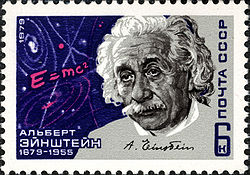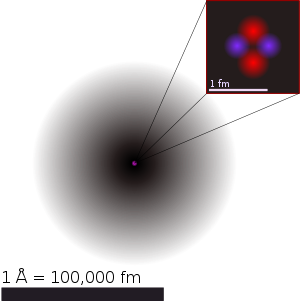
USSR postage stamp dedicated to Albert Einstein
Now we consider the speed of electromagnetic radiation. We already know the inverse square law applies to it, as it does to sound.
We can assume that the speed of electromagnetic radiation (EM) is the speed of light, because in fact it is photons, and they travel at the speed of light. This is not a known fact, but it will make the understanding of or argument easier.
However to understand what this means we must understand what Special Relativity is.
There is a difference between Special Relativity and General Relativity, and general relativity is the one which covers gravity.
One rule is always obeyed regardless of the circumstances: EM radiation in a vacuum always travels at the speed of light, relative to the observer, regardless of the observer's velocity. (This observation led to Albert Einstein's development of the theory of special relativity.)
The term is currently used more generally to refer to any case in which gravitation is not significant. General relativity is the generalization of special relativity to include gravitation. In general relativity, gravity is described using noneuclidean geometry, so that gravitational effects are represented by curvature of spacetime; special relativity is restricted to flat spacetime. Just as the curvature of the earth's surface is not noticeable in everyday life, the curvature of spacetime can be neglected on small scales, so that locally, special relativity is a valid approximation to general relativity.[9] The presence of gravity becomes undetectable in a sufficiently small, free-falling laboratory.
Electromagnetic radiation is classified according to the frequency of its wave. The electromagnetic spectrum, in order of increasing frequency and decreasing wavelength, consists of radio waves, microwaves, infrared radiation, visible light, ultraviolet radiation, X-rays and gamma rays. The eyes of various organisms sense a small and somewhat variable window of frequencies called the visible spectrum. The photon is the quantum of the electromagnetic interaction and the basic "unit" of light and all other forms of electromagnetic radiation and is also the force carrier for the electromagnetic force.
Electromagnetic radiation carries energy - sometimes called radiant energy - and momentum that may be imparted to matter with which it interacts, through absorption of electromagnetic radiation.
Special relativity (SR, also known as the special theory of relativity or STR) is the physical theory of measurement in an inertial frame of reference proposed in 1905 by Albert Einstein (after the considerable and independent contributions of Hendrik Lorentz, Henri Poincaré[1] and others) in the paper "On the Electrodynamics of Moving Bodies".[2]
It generalizes Galileo's principle of relativity—that all uniform motion is relative, and that there is no absolute and well-defined state of rest (no privileged reference frames)—from mechanics to all the laws of physics, including both the laws of mechanics and of electrodynamics, whatever they may be.[3] Special relativity incorporates the principle that the speed of light is the same for all inertial observers regardless of the state of motion of the source.[4]

Speed of electricity (Electromagnetic radiation).
Any electric charge that accelerates, or any changing magnetic field, produces electromagnetic radiation. Electromagnetic information about the charge travels at the speed of light. Accurate treatment thus incorporates a concept known as retarded time (as opposed to advanced time, which is not physically possible in light of causality), which adds to the expressions for the electrodynamic electric field and magnetic field. These extra terms are responsible for electromagnetic radiation. When any wire (or other conducting object such as an antenna) conducts alternating current, electromagnetic radiation is propagated at the same frequency as the electric current. At the quantum level, electromagnetic radiation is produced when the wavepacket of a charged particle oscillates or otherwise accelerates. Charged particles in a stationary state do not move, but a superposition of such states may result in oscillation, which is responsible for the phenomenon of radiative transition between quantum states of a charged particle.
Depending on the circumstances, electromagnetic radiation may behave as a wave or as particles. As a wave, it is characterized by a velocity (the speed of light), wavelength, and frequency. When considered as particles, they are known as photons, and each has an energy related to the frequency of the wave given by Planck's relation E = hν, where E is the energy of the photon, h = 6.626 × 10−34 J·s is Planck's constant, and ν is the frequency of the wave.
One rule is always obeyed regardless of the circumstances: EM radiation in a vacuum always travels at the speed of light, relative to the observer, regardless of the observer's velocity. (This observation led to Albert Einstein's development of the theory of special relativity.)
In a medium (other than vacuum), velocity factor or refractive index are considered, depending on frequency and application. Both of these are ratios of the speed in a medium to speed in a vacuum.